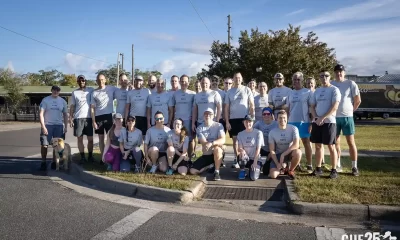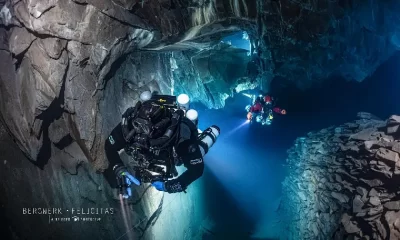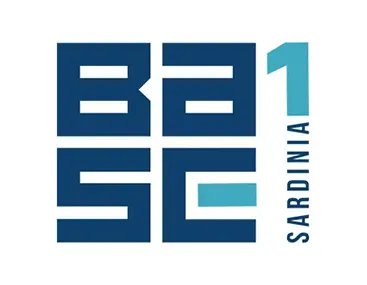Community
To Be, or Not to Be a CCR diver: How I made the choice
By InDEPTH editors

Over the past few months in the pages of InDEPTH, dive-industry experts have waged a debate about the future of open-circuit technical diving. Physiologist Neal Pollock wrote that CCR should be the platform of choice for big dives and Global Underwater Explorers Chairman Jarrod Jablonski told InDEPTH “anyone doing anything of merit” will do so on CCR. TDI instructor trainer and tech pioneer Richard Taylor argues that open circuit technical diving is not dead and remains an essential skill that should be mandatory for CCR divers. GUE instructor Guy Shockey took a deep dive into the economics of closed vs open circuit diving.
InDEPTH asked new technical or CCR divers to tell us how they went about making the decision as to when and why to make the switch from open circuit. Below are responses some of these divers sent to us, edited for length and clarity.
Carl Gosselin, Montreal, Canada plans to take GUE’s CCR1 program instead of its advanced open-circuit technical diving class: I’m a goal-oriented person. A few years ago, when I was ready to jump into technical diving and selected Global Underwater Explorers (GUE) as my training provider, I structured my training as a path towards diving the R.M.S. Empress of Ireland (length 170m, bottom depth 40m), a Tech 1 range wreck near the mouth of the Saint-Lawrence River here in Canada.”
Now that this goal has been achieved, I’m ready to set a new goal for the next level diving in the GUE’s Tech 2 range (170 to 250+ feet). Luckily for me, the Great Lakes between the US and Canada have a lot of interesting wrecks to offer the Canadian diver looking to explore without traveling too far. The northern side of Lake Superior is the resting place of the S.S. Gunilda, one of the world’s best-preserved wrecks according to the Cousteau Society. The Gunilda lies at a depth of 80 meters so that dive requires a tech 2 level certifications.”
What are the paths towards diving the depths of the Gunilda in the GUE curriculum? I can go the classical route and take the Tech 2 class or go toward the CCR training but then need both GUE CCR1 and CCR2 training classes and perform 50 CCR1 level (Same as Tech 1) experience dives between CCR1 and CCR2.”
Considering only time, the choice is easy—pass one GUE training (Tech 2) and I get to reach my goal. It’s easy to see that doing the Tech 2 class will get me to the Gunilda faster, but is it the most efficient avenue to pursue? Will this investment in both my time and money be the best in the long run? What other factors should I consider?”
The logistics of tech diving is not discussed often, but it is a major headache. Interesting wrecks are rarely easily accessible; nor are they near a dive shop. Gear needs to be transported to the dive site or hauled onto a boat. Often multiple dives are required to fully experience a wreck. My experience on the Empress of Ireland, still just a Tech 1 dive, required the transport of three sets of D16 with (Trimix 21/35) and four stages (Nitrox 50%) and 100% oxygen (surface safety) for about 90 min of bottom time. I currently do not have a full dive plan for a dive trip on the Gunilda, but my guess is I will need more gear to manage the depth safely. There are other options to traveling with your gear, but renting also has disadvantages. First, it needs to be available at your destination, but mostly it’s not your gear. If a rebreather-based diving configuration helps me standardize and minimize my technical diving gear requirements, that’s a major incentive to start now on the CCR training path.”
The major drawback of CCR diving are the starting costs: the training and acquisition costs of one’s first unit. But if you’re an avid diver, diving deep or for very long, these costs might be just an investment that will be recovered over time. With the rising costs of helium, being more efficient on this resource will keep narrowing this investment gap.
So, maybe it will take me a little longer to get to dive the Gunilda, but I’ll be able to experience it completely when I do. No more dilemma.
Nadia L. Garibaldi or California, USA, chose to take CCR1 instead of Tech 2: I chose CCR because I’d like to travel and do tech dives and the cost of helium when traveling I think makes CCR worth it.
Also, gas logistics are easier with CCR. For example, driving somewhere to dive with OC means bringing a truckload of gases and often many sets of doubles with different mixes. Instead, CCR enables me to bring just some bailout bottles and figure out what the exact plan is when I get there. In California, we drive to Monterey, Tahoe, Lake Mead, and usually with OC it’s a truckload of tanks.
Finally, I do want to do deeper T2-level dives eventually too. I don’t know that the cost is so much of a concern for me because I wouldn’t be doing T2 dives with a high level of frequency. It is nice not having to bring two sets of bottles for two dives though.
All this was what pushed me into CCR, but the zen, perfect stillness, and silence is delightful!
Martin C. Wright of Weggis, Switzerland believes his open circuit experience helped with CCR: I first went OC Trimix (TDI Advanced) before going the CCR route (now CMAS Switzerland JJ-CCR normoxic TMX).
The path wasn’t so clear-cut as it might be today. I am a CMAS 3-star sports diver (which includes decompression diving as opposed to the US recreational system). However, deeper wrecks such as the Hirondelle in the lake of Geneva called for approaches beyond nitrox diving. This was around the time when the Buddy Inspiration appeared on the market. Due to its price and the initially somber image of ‘yellow box of death’ kept it from being a consideration, so I went the OC technical path.
A couple of years later, a shoulder injury prevented me from reaching my left valve. This was luckily at a time when rising helium prices had me taking a closer look at CCRs. That’s how I got to CCR. Valves are easy to reach for me (in the standard configuration) plus all the other benefits.
Although my OC experience was a bit of a hindering factor to come to grips with CCR buoyancy control and ascents in the beginning, I feel it is a safety factor. Bailing out OC is even harder than regular OC diving, due to the additional requirement of controlling the loop volume … solid OC skills plus stage handling over many dives won’t hurt, and I don’t see how you would get this in a CCR class.
Pedro Boria, Chicago, Illinois, USA
I am TEC 50 /Full Cave and JJ CCR Diver TDI. Just got my GUE Tec pass and my plan is to continue CCR training with GUE for the same reasons described in the article [The Economics of Choosing CCR vs OC]. The biggest reason is the cost of helium and bottom time. In the Chicago area, helium is $3.00 cf/$0.10 L and I dive LP 104s.





















































